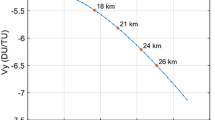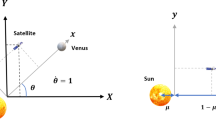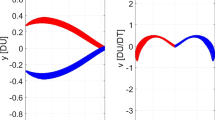Abstract
A method to design ballistic capture orbits in the real Solar System model is presented, so extending previous works using the planar restricted three-body problem. In this generalization a number of issues arise, which are treated in the present work. These involve reformulating the notion of stability in three-dimensions, managing a multi-dimensional space of initial conditions, and implementing a restricted \(n\)-body model with accurate planetary ephemerides. Initial conditions are categorized into four subsets according to the orbits they generate in forward and backward time. These are labelled weakly stable, unstable, crash, and acrobatic, and their manipulation allows us to derive orbits with prescribed behavior. A post-capture stability index is formulated to extract the ideal orbits, which are those of practical interest. Study cases analyze ballistic capture about Mercury, Europa, and the Earth. These simulations show the effectiveness of the developed method in finding solutions matching mission requirements.
















Similar content being viewed by others
Notes
The ephemerides are defined in the International Celestial Reference Frame (ICRF), which has an infinitesimal discrepancy with respect to the EME2000 (Archinal 2011).
Data available at http://naif.jpl.nasa.gov/pub/naif/generic_kernels/spk/planets/de430.bsp, \(\sim \)/satellites/ jup310.bsp, \(\sim \)/sat360.bsp, \(\sim \)/ura111.bsp, \(\sim \)/nep081.bsp, and \(\sim \)/plu043.bsp [retrieved 5 May 2014].
Data available at http://naif.jpl.nasa.gov/naif/toolkit.html [retrieved 5 May 2014].
References
Archinal, B.A., et al.: Report of the IAU working group on cartographic coordinates and rotational elements: 2009. Celest. Mech. Dyn. Astron. 109(2), 101–135 (2011). doi:10.1007/s10569-010-9320-4
Battin, R.H.: An Introduction to the Mathematics and Methods of Astrodynamics, p. 125. AIAA, New York (1987)
Belbruno, E.: Capture Dynamics and Chaotic Motions in Celestial Mechanics: With Applications to the Construction of Low Energy Transfers. Princeton University Press, Princeton (2004)
Belbruno, E., Miller, J.: Sun-perturbed Earth-to-Moon transfers with ballistic capture. J. Guid. Control Dyn. 16, 770–775 (1993). doi:10.2514/3.21079
Belbruno, E., Gidea, M., Topputo, F.: Weak stability boundary and invariant manifolds. SIAM J. Appl. Dyn. Syst. 9(3), 1061–1089 (2010). doi:10.1137/090780638
Belbruno, E., Gidea, M., Topputo, F.: Geometry of weak stability boundaries. Qual. Theory Dyn. Syst. 12(1), 53–66 (2013). doi:10.1007/s12346-012-0069-x
Belbruno, E., Topputo, F., Gidea, M.: Resonance transitions associated to weak capture in the restricted three-body problem. Adv. Space Res. 42(8), 18–39 (2008). doi:10.1016/j.asr.2008.01.018
Campagnola, S., Buffington, B., Petropoulos, A.: Jovian tour design for orbiter and lander missions to Europa. Acta Astronaut. 100, 68–81 (2014). doi:10.1016/j.actaastro.2014.02.005
Ceccaroni, M., Biggs, J., Biasco, L.: Analytic estimates and topological properties of the weak stability boundary. Celest. Mech. Dyn. Astron. 114(1–2), 1–24 (2012). doi:10.1007/s10569-012-9419-x
Chung, M.J., Hatch, S.J., Kangas, J.A., Long, S.M., Roncoli, R.B., Sweetser, T.H.: Trans-lunar cruise trajectory design of GRAIL (gravity recovery and interior laboratory) mission. In: AIAA/AAS Astrodynamics Specialist Conference, AIAA 2010, vol. 8384, pp. 2–5. Toronto, Ontario (2010)
Circi, C.: Properties of transit trajectory in the restricted three and four-body problem. Adv. Space Res. 49(10), 1506–1519 (2012). doi:10.1016/j.asr.2012.02.034
Circi, C., Teofilatto, P.: On the dynamics of weak stability boundary lunar transfers. Celest. Mech. Dyn. Astron. 79(1), 41–72 (2001). doi:10.1023/A:1011153610564
Circi, C., Teofilatto, P.: Effect of planetary eccentricity on ballistic capture in the solar system. Celest. Mech. Dyn. Astron. 93(1–4), 69–86 (2005). doi:10.1007/s10569-005-3640-9
Elliot, J., Alkalai, L.: Lunette: a network of lunar landers for in-situ geophysical science. Acta Astronaut. 68, 1201–1207 (2011)
Fantino, E., Gómez, G., Masdemont, J., Ren, Y.: A note on libration point orbits, temporary capture and low-energy transfers. Acta Astronaut. 67(9–10), 1038–1052 (2010). doi:10.1016/j.actaastro.2010.06.037
Folkner, W.M., Williams, J.G., Boggs, D.H., Park, R.S., Kuchynka, P.: The Planetary and Lunar Ephemerides DE430 and DE431, Technical report, IPN Progress Report, pp. 42–196 (2014)
García, F., Gómez, G.: A note on weak stability boundaries. Celest. Mech. Dyn. Astron. 97, 87–100 (2007). doi:10.1007/s10569-006-9053-6
Gómez, G., Jorba, A., Masdemont, J., Simó, C.: Study of the transfer from the Earth to a halo orbit around the equilibrium point L1. Celest. Mech. Dyn. Astron. 56, 541–562 (1993)
Hyeraci, N., Topputo, F.: Method to design ballistic capture in the elliptic restricted three-body problem. J. Guid. Control Dyn. 33(6), 1814–1823 (2010). doi:10.2514/1.49263
Hyeraci, N., Topputo, F.: The role of true anomaly in ballistic capture. Celest. Mech. Dyn. Astron. 116(2), 175–193 (2013). doi:10.1007/s10569-013-9481-z
Jehn, R., Campagnola, S., García, D., Kemble, S.: (2004) Low-thrust approach and gravitational capture at Mercury. In: Proceedings of the 18th International Symposium on Space Flights Dynamics, vol. 584, p. 487. Munich, Germany
Koon, W.S., Lo, M.W., Marsden, J.E., Ross, S.D.: Low energy transfer to the Moon. Celest. Mech. Dyn. Astron. 81, 63–73 (2001)
Koon, W.S., Lo, M.W., Marsden, J.E., Ross, S.D.: Constructing a low energy transfer between Jovian moons. Contemp. Math. 292, 129–145 (2002)
Makó, Z.: Connection between Hill stability and weak stability in the elliptic restricted three-body problem. Celest. Mech. Dyn. Astron. 120(3), 233–248 (2014). doi:10.1007/s10569-014-9577-0
Makó, Z., Szenkovits, F.: Capture in the circular and elliptic restricted three-body problem. Celest. Mech. Dyn. Astron. 90, 51–58 (2004). doi:10.1007/s10569-004-5899-7
Makó, Z., Szenkovits, F., Salamon, J., Oláh-Gál, R.: Stable and unstable orbits around Mercury. Celest. Mech. Dyn. Astron. 108, 357–370 (2010). doi:10.1007/s10569-010-9309-z
Mingotti, G., Topputo, F., Bernelli-Zazzera, F.: Low-energy, low-thrust transfers to the Moon. Celest. Mech. Dyn. Astron. 105(1–3), 61–74 (2009). doi:10.1007/s10569-009-9220-7
Mingotti, G., Topputo, F., Bernelli-Zazzera, F.: Efficient invariant-manifold, low-thrust planar trajectories to the Moon. Commun. Nonlinear Sci. Numer. Simul. 17(2), 817–831 (2012). doi:10.1016/j.cnsns.2011.06.033
Parker, J.: Establishing a network of lunar landers via low-energy transfers. In: 24th AAS/AIAA Space Flight Mechanics Meeting, Santa Fe, New Mexico, 26–30 January, pp. 1–21 (2014)
Romagnoli, D., Circi, C.: Earth–Moon weak stability boundaries in the restricted three and four body problem. Celest. Mech. Dyn. Astron. 103(1), 79–103 (2009). doi:10.1007/s10569-008-9169-y
Russell, R.P.: Survey of Spacecraft Trajectory Design in Strongly Perturbed Environments. Journal of Guidance, Control, and Dynamics 35(3), 705–720 (2012). doi:10.2514/1.56813
Schoenmaekers, J., Horas, D., Pulido, J.A.: SMART-1: with solar electric propulsion to the Moon. In: Proceeding of the 16th International Symposium on Space Flight Dynamics, pp. 3–7. Pasadena, California (2001)
Sousa Silva, P., Terra, M.: Applicability and dynamical characterization of the associated sets of the algorithmic weak stability boundary in the lunar sphere of influence. Celest. Mech. Dyn. Astron. 113, 141–168 (2012a). doi:10.1007/s10569-012-9409-z
Sousa Silva, P., Terra, M.: Diversity and validity of stable-unstable transitions in the algorithmic weak stability boundary. Celest. Mech. Dyn. Astron. 113, 453–478 (2012b). doi:10.1007/s10569-012-9418-y
Szebehely, V.: Theory of orbits: The Restricted Problem of Three Bodies. Academic Press Inc., Academic Press Inc (1967)
Topputo, F.: On optimal two-impulse Earth–Moon transfers in a four-body model. Celest. Mech. Dyn. Astron. 117(3), 279–313 (2013). doi:10.1007/s10569-013-9513-8
Topputo, F., Belbruno, E.: Computation of weak stability boundaries: Sun–Jupiter system. Celest. Mech. Dyn. Astron. 105(1–3), 3–17 (2009). doi:10.1007/s10569-009-9222-5
Topputo, F., Belbruno, E., Gidea, M.: Resonant motion, ballistic escape, and their applications in astrodynamics. Adv. Space Res. 42(8), 6–17 (2008). doi:10.1016/j.asr.2008.01.017
Urrutxua, H., Scheeres, D., Bombardelli, C., Gonzalo, J.L., Pelaez, J.: What does it take to capture an Asteroid? A case study on capturing Asteroid 2006 RH120. In 24th AAS/AIAA Space Flight Mechanics Meeting, Santa Fe, New Mexico, 26–30 January, pp. 1–20 (2014)
Vetrisano, M., Van der Weg, W., Vasile, M.: Navigating to the moon along low-energy transfers. Celest. Mech. Dyn. Astron. 114(1–2), 25–53 (2012). doi:10.1007/s10569-012-9436-9
Yagasaki, K.: Sun-perturbed Earth-to-Moon transfers with low energy and moderate flight time. Celest. Mech. Dyn. Astron. 90, 197–212 (2004). doi:10.1007/s10569-004-0406-8
Acknowledgments
The first author acknowledges financial support from China Scholarship Council and the Innovation Fund of National University of Defense Technology under Grant No. B100101.
Author information
Authors and Affiliations
Corresponding author
Rights and permissions
About this article
Cite this article
Luo, ZF., Topputo, F., Bernelli-Zazzera, F. et al. Constructing ballistic capture orbits in the real Solar System model. Celest Mech Dyn Astr 120, 433–450 (2014). https://doi.org/10.1007/s10569-014-9580-5
Received:
Revised:
Accepted:
Published:
Issue Date:
DOI: https://doi.org/10.1007/s10569-014-9580-5




